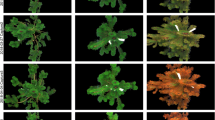Abstract
Eight pieces of sapwood and heartwood from Scots pine, before and after linseed oil impregnation, were used to make 16 near-infrared hyperspectral images (90–200 pixels wide × 466–985 pixels long × 239 wavelengths: 982–2,480 nm). The wood pieces were selected according to a 2 × 2 experimental design using radial–tangential cut and heartwood–sapwood as factors with two replicates. A first mosaic of 16 images was cleaned and analyzed by image principal component analysis. Interpretation was realized by studying score images and score plots by brushing interaction. In the resulting T1–T2 score plot, the untreated pieces formed a dense cluster, while the impregnated ones showed larger variation. The good separation of treated and impregnated clusters was confirmed by PLSDA showing low false negatives and positives. Analysis of the eight impregnated wood pieces clearly showed regions of wrong impregnation in one wood piece. Loadings resembling linseed oil spectra indicated that this was due to badly polymerized linseed oil. After removing the outlier piece, a new model was made on the seven-piece mosaic showing in the T1–T2 score plot that heartwood and sapwood absorbed the linseed oil differently. This difference was not detected in the untreated wood, so it had to come from the impregnation process. Edges reacted differently from surfaces to the impregnation process as seen in the T1–T4 score plot. These findings show that a future online quality inspection of both raw wood and impregnated pieces would be feasible.







Similar content being viewed by others
References
Burger J, Geladi P (2005) Hyperspectral NIR image regression part I: calibration and correction. J Chemom 19:355–363
Chang C (ed) (2007) Hyperspectral data exploitation: theory and applications. Wiley, Chichester
Eriksson L, Johansson E, Kettaneh-Wold N, Trygg J, Wikström C, Wold S (2006), Mega- and multivariate data analysis. Part 1, basic principles and applications, Umetrics, Umeå, Sweden
Eriksson D, Geladi P, Ulvcrona T (2011) Near-infrared spectroscopy for the quantification of linseed oil uptake in Scots pine (Pinus sylvestris L.). Wood Mat Sci Eng 6:170–176
Geladi P, Grahn H (1996) Multivariate image analysis. Wiley, Chichester
Geladi P, Burger J, Lestander T (2004) Hyperspectral imaging: calibration problems and solutions. Chemometr Intell Lab Syst 72:209–217
Geladi P, Grahn H, Manley M (2010) Data analysis and chemometrics for hyperspectral imaging. In: Šašić S, Ozaki Y (eds) Raman, infrared and near-infrared chemical imaging. Wiley, Hoboken, pp 93–107
Grahn H, Geladi P (eds) (2007) Techniques and applications of hyperspectral image analysis. Wiley, Chichester
Heise H, Winzen R (2002) Chemometrics in near-infrared spectroscopy. In: Siesler H, Ozaki Y, Kawata S, Heise M (eds) Near infrared spectroscopy, principles, instruments, applications. Wiley, Weinheim, pp 125–162
Khalili S, Nilsson T, Daniel G (2001) The use of soft-rot fungi for determining the microfibrillar orientation in the S2 layer of pine tracheids. Holz Roh Werkst 58:439–447
Lazzarri M, Chiantore O (1999) Drying and oxidative degradation of linseed oil. Polym Degrad Stab 65:303–313
Manley M, Mc Goverin C, Engelbrecht P, Geladi P (2012) Influence of grain topography on hyperspectral images. Talanta 89:223–230
Næs T, Isaksson T, Fearn T, Davies T (2002) A user-friendly guide to multivariate calibration and classification. NIR Publications, Chichester
Panov D, Terziev N, Daniel G (2010) Using plant oils as hydrophobic substances for wood protection. In: Proceedings, IRG 41 Annual Meeting, Biarritz, France, 9–13 May 2010
Šašić S, Ozaki Y (eds) (2010) Raman infrared and near-infrared chemical imaging. Wiley, Hoboken
Terziev N, Panov D (2011) Plant oils as “green” substances for wood protection. In: Caldera F, Ferreira JV, Petric M, Rowel RM (eds) Minimizing the environmental impact of the forest products industries. University Fernando Pessoa Praca, Portugal, pp 139–146
Ulvcrona T (2006) Impregnation of Norway spruce (Picea abies L. Karst.) wood with hydrophobic oil, Doctoral thesis, Swedish University of Agricultural Sciences, Umeå
Ulvcrona T, Flaete P-O, Alfredsen G (2012) Effects of lateral wood zone on brown rot resistance of untreated and linseed oil-impregnated Scots pine wood. Eur J Wood Prod 70:771–773
Vagnini M, Liliani C, Cartechini L, Rocchi P, Brunetti B, Sgamelotti A (2009) FT-NIR spectroscopy for non-invasive identification of natural polymers and resins in easel paintings. Anal Bioanal Chem 395:2107–2118
Varmuza K, Filzmoser P (2009) Introduction to multivariate statistical analysis in chemometrics. CRC Press, Boca Raton
Williams P, Geladi P, Fox G, Manley M (2009) Maize kernel hardness classification by near infrared (NIR) hyperspectral imaging and multivariate data analysis. Anal Chim Acta 653:121–130
Acknowledgments
The work was financed by the Kempe Foundations and Sveaskog AB. PG acknowledges FIELD NIRce a Botnia-Atlantica (Interreg IV-EU) project.
Author information
Authors and Affiliations
Corresponding author
Rights and permissions
About this article
Cite this article
Geladi, P., Eriksson, D. & Ulvcrona, T. Data analysis of hyperspectral NIR image mosaics for the quantification of linseed oil impregnation in Scots pine wood. Wood Sci Technol 48, 467–481 (2014). https://doi.org/10.1007/s00226-014-0622-7
Received:
Published:
Issue Date:
DOI: https://doi.org/10.1007/s00226-014-0622-7




